Player’s Actions & Blackjack
How to Deal Blackjack: Part 7
Table of Contents
How to Deal BlackjackFurther Reading
- Part 1: Introduction
- Part 2: Shuffling
- Part 3: Washing Cards, Cutting Deck, Burning Card, Drills
- Part 4: Delivering Cards, Pitching, Tucking Hole Cards, Checking Ace & 10
- Part 5: Handling Cheques, Playing the Game
- Part 6: Take & Pay Procedure
- Part 7: Player’s Actions & Blackjack
- Part 8: Color Up, Dead Game, & Other Procedures
- Part 9: Dealer’s Break, Tokes, Customer Service & Other Policies
- Part 10: Game Security
Did this free course help you?
Click to leave a tip to help keep this resource free!
Double Down
Double Down on a Shoe Game
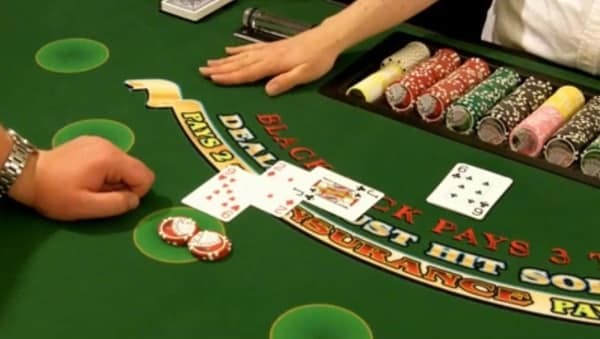
The double down card is delivered face up and perpendicular to the last card in the hand.
Doubling Down on a Handheld Game
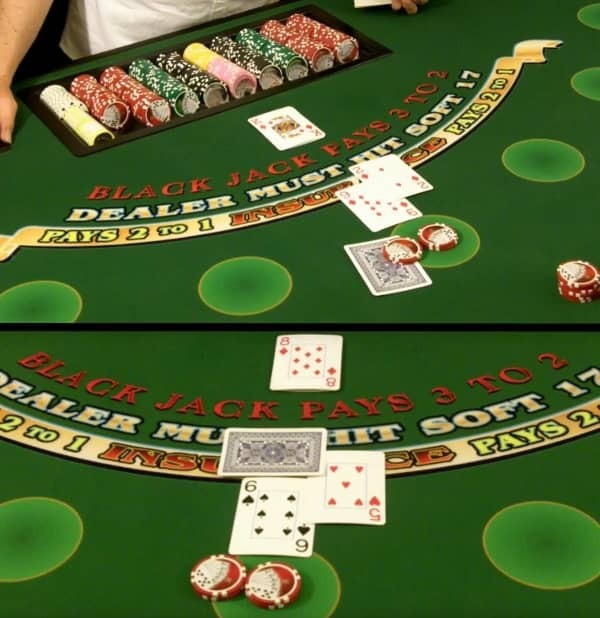
There are 2 ways to deliver a double down card on a handheld game, the first and most popular way is to place the hit card face down under the players double down bet. The second way to deliver the card is face down and perpendicular to the last card.
Doubling For Less
It is an abnormal move, you must give an alert call to your floor by calling out “Doubling for less”. If the player wins, make sure you pay each bet individually.
Doubling on a Hard 12 or Higher
This is another odd move that players do when they are counting cards. Always verify the player’s decision before you call out “Doubling on a hard 12”. Always deliver the card face up because if the player busts then the bet must be immediately taken.
Splitting
Make sure that the player does not bet less than their original bet. When one hand is a win and one hand is a loss, pay or take the bet individually. Don’t just leave it, this is lazy and it looks bad for the cameras. On a handheld game, a split must be dealt face up. The player must use the same hand signals that they would on a shoe game. Depending on the casino a player may or may not be allowed to double down after a split.
Surrender
Surrender is available at some casinos. the player will announce “Surrender” and using their fingers will draw a line behind their bet. You will take the players bet and place it in the center left of the table. Then with clean money, you will put up half of the amount of the bet. Place it on the center right part of the table where the cameras can see it. Then place the clean money in the betting circle. Pick up the cards and place them in the discard rack. If you have an ace up card do not allow surrender until you’ve checked to see if you have a blackjack. The player cannot take Surrender if the dealer has a blackjack.
Blackjack
If a player gets a blackjack then they get paid 3 to 2 or 1 ½ times their bet. As soon as the bet has been paid, the cards should be put in the discard rack. When it comes to paying a blackjack the 3:2 payoff is easier than it looks, you just pay the entire bet plus half.
Just in case, I provided a chart with bets and their blackjack payoffs.
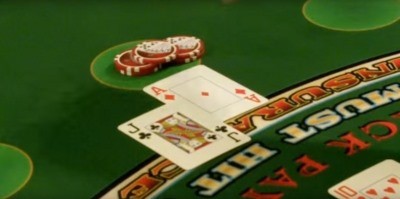
There are two ways to pay a blackjack, the first and most popular way is to bridge the payoff.
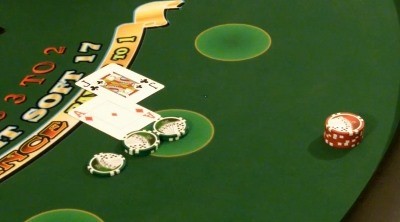
The second way is to place the payoff next to the original bet and then place the bonus amount next to the payoff. Remember to never alter or convert any part of the original bet. If there is a tip for the dealer, then that gets paid 3 to 2 as well.
Insurance
When you show an ace up card, you will turn the card sideways and offer “Insurance” while running your hand over the full length of the insurance line. Wait 5 seconds to give the players time to decide but don’t take too long because you need to keep the game moving. The players must place their insurance wagers on the Insurance line for it to be a valid bet. As the dealer you must check to see if the player is over the maximum amount which is ½ of the original bet. When everyone has decided, run your hand back across the insurance line while saying, “Insurance is closed”. Why does the dealer need to say, “Insurance is closed”? Because saying this protects you from a player who put money on the insurance line after you’ve flip the hole card and then claiming it as a legitimate bet.
Even Money
If a player has a blackjack and they insist on taking insurance, explain to them that taking “Even money” is exactly the same thing. If you have an ace up card and the player has a blackjack then ask the player if they want “Even Money”. If the player says yes, then before looking at your hole card, pay 1:1 on the player’s original bet. Take the cards and place them into the discard rack and then check the hole card. The total amount of the insurance bet can be combined and placed on the insurance line in the middle.
Single Deck
You only have one cut card that must be placed on the bottom of the deck, so how do you know when to shuffle? You don’t want to be all out of cards in the middle of a hand, you could get written up for that. Because of this you are given a formula for when to shuffle. You are only allowed to deal a certain number of hands based on the number of players. If you have 1 player at your table then you deal him 5 hands before you have to shuffle. If you have 2 players then you deal them 4 hands. If you have 3 players then you deal them 3 hands. And, if you have 4 or more players at your table then you deal them 2 hands before shuffling.
On single deck, blackjack only pays 6 to 5, not 3 to 2. So for every $5 bet you pay $6. The dealer’s tip would also get paid 6 to 5. If the player has an uneven bet that is not divisible by 5, then only pay even money on the odd amount above the normal blackjack payoff.
On most single decks there is no mid deck entry. This means that no new players can start playing until the dealer shuffles the deck. At some casinos, players can only double down on 9, 10, or 11 and cannot double down after a split.
Change
Making Change
You will complete this procedure multiple times per day. It will be completed by exchanging currency for equal or lessor value cheques. There are two scenarios when “Making Change”:
Change
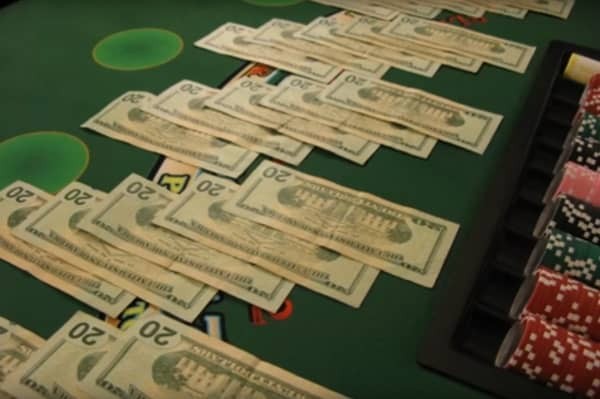
When the player hands you money you need to change it into cheques. Take the cash and spread it across the left side of the table with the back of the bill facing up and all the bills facing the same direction and down. Separate the different denominations.
Alert the floor by calling out “Change $100”. The floor has to keep track of how much money you drop so you must always notify the floor if the change is $100 or more. Take the cheques out, cut them and verify the amount. Take your hand away from the cheques and wait a couple seconds so the cameras can get a clear shot. Stack up the cheques and hand them over to the player. When handing cheques to a player never put the cheques in a closed fist or in both hands.

Slide the stack using the bottom fingers to move the stack while the forefinger keeps the stack steady.

Once the player has all of their cheques, pick up the currency with your left hand and then using your right hand pick up the paddle, place the money over the hole and slide the paddle in, dropping it in the drop box.
Never drop the cash in the drop box before handing the player their cheques. There is a certain way to break down currency. $1 bills are placed in rows of 5 and each column is worth $5, (label + 5 per column) $5 bills are placed in the same way and they’re worth $25 per column (label + 5 per column), $10 bills are worth $50 per column, $20 bills are worth $100 per column and $100 bills are worth $500 per column. Place the currency length-wise and use the paddle to slide it into the drop box.
If you have a large sum of money; then use this trick to get the cash in the drop box without a paddle:

Cheque Change
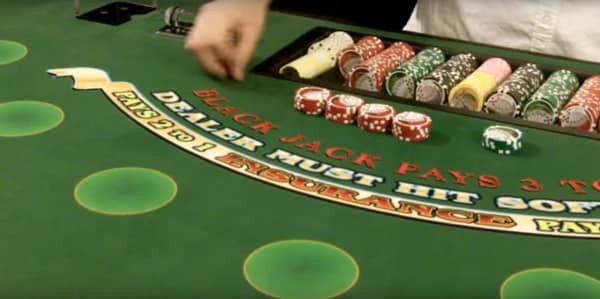
When the player hands you a large value cheque then you need to exchange it for smaller value cheques. Take the cheques and place it on the left side of the table. Take out a handful of the lessor denomination cheques; bring them to right of the center of the table and size into them verifying the correct amount.
Call out “Cheque Change $100” and after receiving approval, slide the stack of cheques to the player. Pick up the cheque change and place it in the rack. Never put the cheque change in the rack first and then hand the change to the player! And never drop the cheque change into the drop box if it is from your casino, put it in the rack instead. The only time you would drop cheques in the drop box is if they are foreign cheques.
